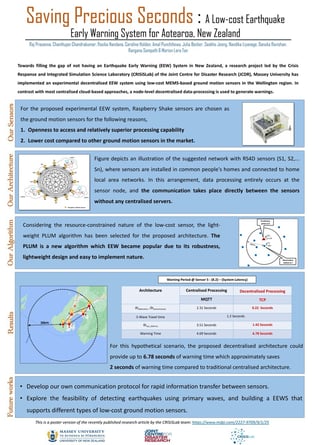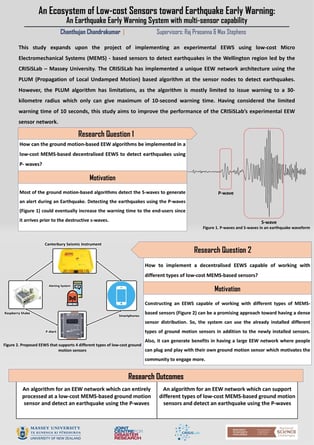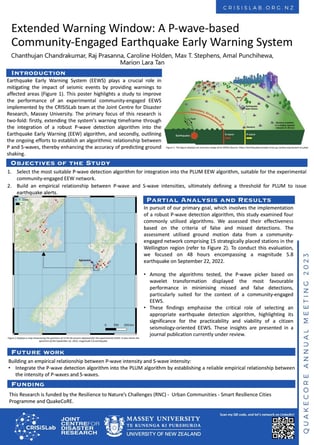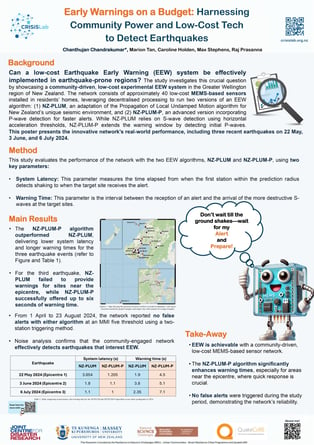About Me
Hello! I’m Chanthujan Chandrakumar, a researcher specialising in Earthquake Early Warning (EEW), seismic data processing, and real-time data analytics. I recently completed my PhD in Emergency Management focusing on Information Systems at Massey University’s Joint Centre for Disaster Research, where I developed a community-engaged, low-cost EEW system for New Zealand.
My research focused on designing and implementing a decentralised EEW network using low-cost sensors, real-time seismic data processing, and algorithm optimisation for earthquake detection and alert generation. By integrating seismic algorithms, my work demonstrated the feasibility of deploying cost-effective EEW systems through citizen science, reducing the blind zone and increasing warning times for earthquakes.
I am also a proud member of CrisisLab, where I collaborate with other experts in the field to develop advanced solutions for disaster management.
Before starting my research career, I worked as a Senior Application Engineer at Synopsys Inc. in Sri Lanka.
Outside of my research, I am a fitness enthusiast and an avid road cyclist, constantly exploring the stunning landscapes of New Zealand.


Interests
Education
PhD in Information Systems, (2021 – 2024)
Massey University, New ZealandBachelor of the Science of Engineering (Hons) in Electronic and Telecommunication Engineering, (2014 – 2018)
University of Moratuwa, Sri Lanka
Data Analytics
Early Warning Systems
Seismology
Wireless Sensor Networks
Edge computing
Data Science
Featured Publications
This research explores using Micro-Electromechanical Systems (MEMS)-based technologies for earthquake early warning (EEW). It introduces a unique EEW architecture driven by Software-Defined Wide Area Network (SD-WAN) technology, featuring MEMS-based, low-cost accelerometers hosted by the general public. Unlike centralised cloud-based systems, this approach uses node-level decentralised data processing to generate warnings, supported by a modified Propagation of Local Undamped Motion (PLUM)-based algorithm. The study demonstrates that the proposed decentralised EEW system architecture outperforms traditional centralised systems, providing longer warning times and potentially saving valuable seconds during an earthquake.
This systematic literature review investigates the potential of low-cost Micro-Electromechanical Systems (MEMS)-based ground motion sensors for constructing affordable, reliable, and robust Earthquake Early Warning Systems (EEWS). By reviewing 59 articles, this paper highlights how MEMS-based sensors can make EEWSs feasible for developing countries and support high-end systems by increasing sensor density. The study classifies EEWSs based on warning types and algorithms, summarising various approaches to developing these systems. It also addresses challenges in implementing and maintaining low-cost MEMS-based EEWSs and suggests future research areas, including node-level processing, multi-sensor support, and ground motion-based algorithms.
This paper presents initial findings from a literature review on algorithms used for P-wave detection and earthquake magnitude estimation in Earthquake Early Warning Systems (EEWS). EEWSs are critical in alerting the public and authorities to take safety measures during an earthquake. Typically, EEWSs employ source-based, ground motion-based, and on-site-based algorithms, with source-based approaches being the most prevalent globally. These systems use P-wave data to estimate earthquake source parameters, such as magnitude and location. This Work in Progress paper (WiPe) aims to identify the most effective algorithms for leveraging P-waves to generate timely and accurate earthquake alerts.
This study uses low-cost ground motion sensors to examine the effectiveness of various P-wave detection algorithms within a community-engaged Earthquake Early Warning System (EEWS). Focusing on data from 48 hours around the M5.8 Cook Strait earthquake on 22 September 2022, the study evaluates the performance of four P-wave detection algorithms, analysing false and missed detections. The findings reveal that a wavelet transformation-based P-wave picker is the most effective algorithm, minimising false and missed detections. The research underscores the potential of citizen seismology-based EEWSs to detect seismic events and suggests future improvements, such as dynamically adjusting P-wave detection thresholds and enhancing citizen seismologists’ user experience and involvement.
This study explores the feasibility of implementing the Propagation of Local Undamped Motion (PLUM) algorithm within a community-engaged earthquake early warning (EEW) network, operating effectively at the node level without centralised processing units. Using cost-effective MEMS-based seismographs, the research decentralises EEW by deploying sensors and establishing a two-tiered Primary-Secondary node structure for intensity prediction and alert generation. The preliminary findings demonstrate the practicality of node-level processing for earthquake alerts. Future work includes calibrating thresholds for optimal alert issuance and expanding the network to minimise blind spots. This work-in-progress aims to develop a scalable and efficient EEW system that can be replicated in earthquake-prone regions worldwide, enhancing community preparedness against seismic threats.
This research focuses on predicting the amplitude of S-waves during earthquakes in Aotearoa New Zealand, a region highly susceptible to seismic activity, to enhance Earthquake Early Warning Systems (EEWS). By analysing ground motion parameters from historical earthquakes in the Canterbury region, the study aims to estimate damaging S-wave amplitudes using initial P-wave signals. It establishes nine linear regression models between P-wave and S-wave amplitudes, focusing on peak ground acceleration, peak ground velocity, and peak ground displacement. The findings indicate that the relationship between P-wave Peak Ground Velocity (Pv) within a 3-second window and S-wave Peak Ground Acceleration (PGA) is the most predictive for EEWS. This empirical model is then applied to determine a P-wave amplitude threshold for the Canterbury region, providing valuable insights for developing effective EEWS.
Accurate and timely P-wave detection minimises false, late, and missed alerts in Earthquake Early Warning (EEW) systems. This study evaluates four P-wave detection algorithms using a MEMS-based ground motion dataset from the GeoNet network. By introducing distinct pick deviation categories, the research identifies the wavelet-based P-wave picker as the most effective, achieving a 98.3% success rate with minimal deviation from manual picks. The findings support its use in both community-engaged and traditional EEW systems. This methodology can be applied to other datasets, guiding the selection of reliable P-wave detection algorithms for improved seismic early warning.
This study explores the feasibility of building a cost-effective Earthquake Early Warning (EEW) system using a community-hosted sensor network in the Greater Wellington region. Two algorithms—NZ-PLUM and NZ-PLUM-P—are tested, with NZ-PLUM-P showing longer warning times by detecting P-waves earlier. With zero false alerts and successful detection of recent local earthquakes, the research demonstrates that decentralised, community-engaged networks can effectively deliver timely alerts. The approach offers a practical model for earthquake-prone regions aiming to implement or improve EEW systems.
Achievements
People’s Choice Award at the Massey 3-min Lightning Talk event 2023
Best Student Paper Award at the Award at the 21st ISCRAM Conference 2024
First place at the QuakeCoRE Wellington chapter 5-min Lightning Talk 2024
Audience Choice Award at the QuakeCoRE Annual Meeting 5-min Lightning Talk 2024
Third place at the QuakeCoRE Wellington chapter 5-min Lightning Talk 2022
Third place at the QuakeCoRE Wellington chapter 5-min Lightning Talk 2023
Technical lead in organising the CRISiSLab Challenge Event 2022 and 2023
Head of the organising committee for the Disastrous Doctorates Symposium 2023
Vice president of QuakeCoRE Wellington Chapter 2023
Treasurer of the QuakeCoRE Wellington Chapter 2022
Committee Leadership
Awards


Contact Information
Reach out to me for collaborations and inquiries








